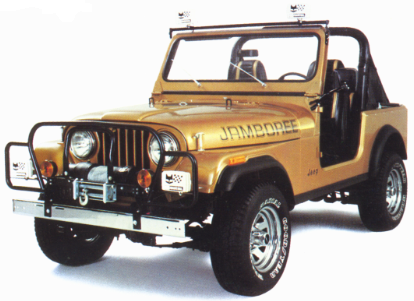
The Rarest CJ-7 Ever Built &
One of the Rarest Jeeps of All Time

UA-83787031-1
 |
1982 Jeep CJ-7 Jamboree The Rarest CJ-7 Ever Built & One of the Rarest Jeeps of All Time  |
| Main | Jambo Registry(TM) | Production | The Jambo | History |
| Parts | Documents | FAQs | Fun | About |
| For Sale: Parts | For Sale: Jambos | Links | Restoration | Silver Registry(TM) |
Jeep planned to produce 2500 Jambos. However, the economy was in recession in 1982 and Jeep sales were down 50% from prior years. For example, accoding to Jim Allen's Jeep Collector's Library, Jeep sold 41,501 CJ-5s in 1979 and only 23,820 CJ-7s in 1982. The CJ-7 sales figures in 1982 were the second lowest of the 11 years it was produced. The lowest was 21,016 in 1976, which was the first year of CJ-7 production.
In total, The Jambo Registry estimates that around 630 Jambos were actually built. This makes the Jambo one of the rarest Jeeps ever produced. We believe, nearly 200 more 1979 CJ-5 Silver Anniversaries were produced. Just about as many 1971 Renegade IIs were produced as Jambos. Of the approximately 630 Jambos, The Jambo Registry estimates that about 560 (89%) were Topaz Gold Metallic (2H) and 70 (11%) were Olympic White (9B).
The Jambos were produced in two groups: The Gold (G) Group and the Mixed (M) Group. Below is a plot of Jambo plaque numbers versus sequential serial numbers for approximately 163 registered Jambos. The Jambos that we show with a -100 plaque number are those that are missing badges. The gold dots represent Topaz Gold Jambos and the open dots represent Olympic White Jambos. As you can see, the G group included only Topaz Gold Metallic Jambos. After this initial run of Jambos, Jeep introduced some Olympic White Jambos during the M group production.
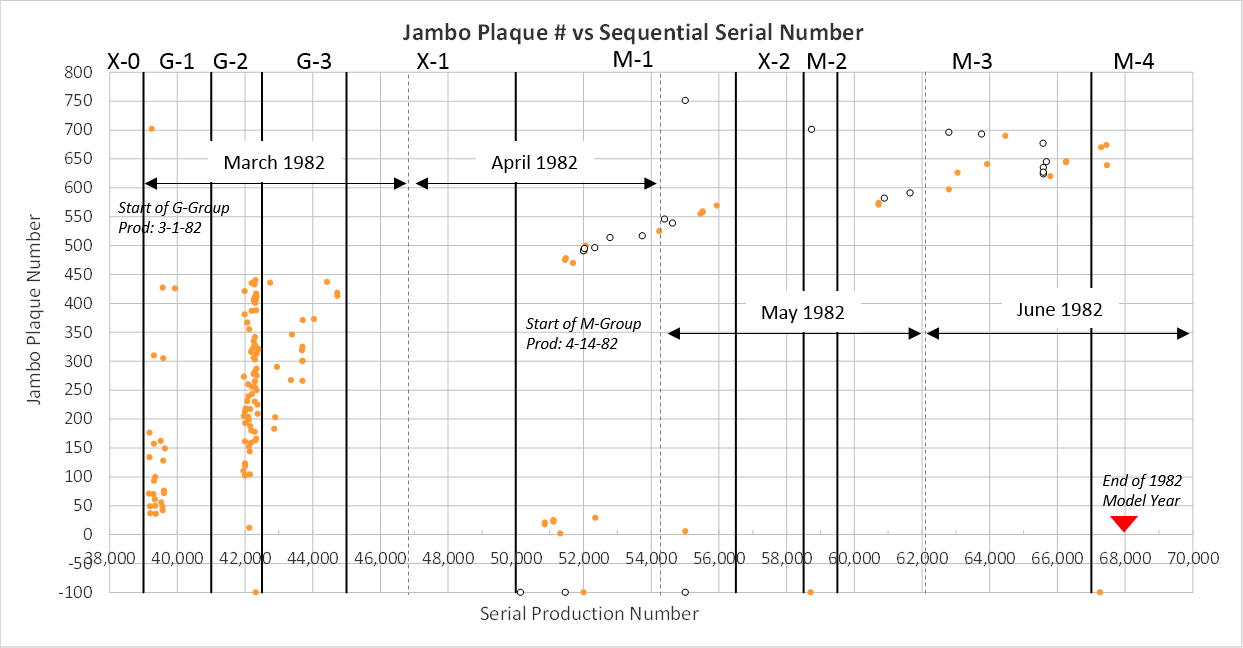
As we explain below, G-1, G-2, and G-3 are the three batches that compose the G group. M-1 to M-4 are the four batches of the M group. X-0, X-1, and are gaps in Jambo production where we currently believe no Jambos were made. For example, X-0 runs from serial number 000001 to 039000--no Jambos were produced prior to serial number 039000.
We estimate that Jambo production began March 1, 1982. This is supported by internal Jeep documents that specified Jambo production would be part of the March production run and that Jambos would be offered to the public beginning April 1, 1982. We believe the Mixed group production started around mid-April and was complete by the last week of June 1982. This was in advance of the 30th Anniversary Jeepers Jamboree, which was held July 22-25, 1982.
We estimate that Jeep produced about 250 vehicles per day (5500 per month) in 1982. So, the time between serial numbers 40,000 and 42,000 is about 8 days. The plot above shows the timeframe over which we believe the Jambos were produced. The G group was produced during first three weeks of March 1982. Then Jeep took about a three-week break from Jambo production. This is when the dealers would have received their initial Topaz Gold Metallic Jambos and taken new orders. These new orders were filled starting in mid-April 1982. The final run of Jambos began in mid-June 1982 and was completed by the end of that month.
We believe the highest 1982 serial number is around 068000 (this includes all Jeep vehicles) and that 1982 model year production was over by the end of June. This seems early. For example, we believe the 1982 model year started September 1, 1981. If the 1983 model year started September 1, 1982, that would leave July and August 1982 with no production. That is 1/6-th of a year or 17%. This could make sense because 1982 CJ-7 sales were down 14% from 1981. So, perhaps, Jeep decided to pause 1982 production for a couple of months, before moving over to the 1983 model year.
Here is a chart of Jambo badge number vs estimated production date. You can help us figure out when the Jambos were produced by reading this.
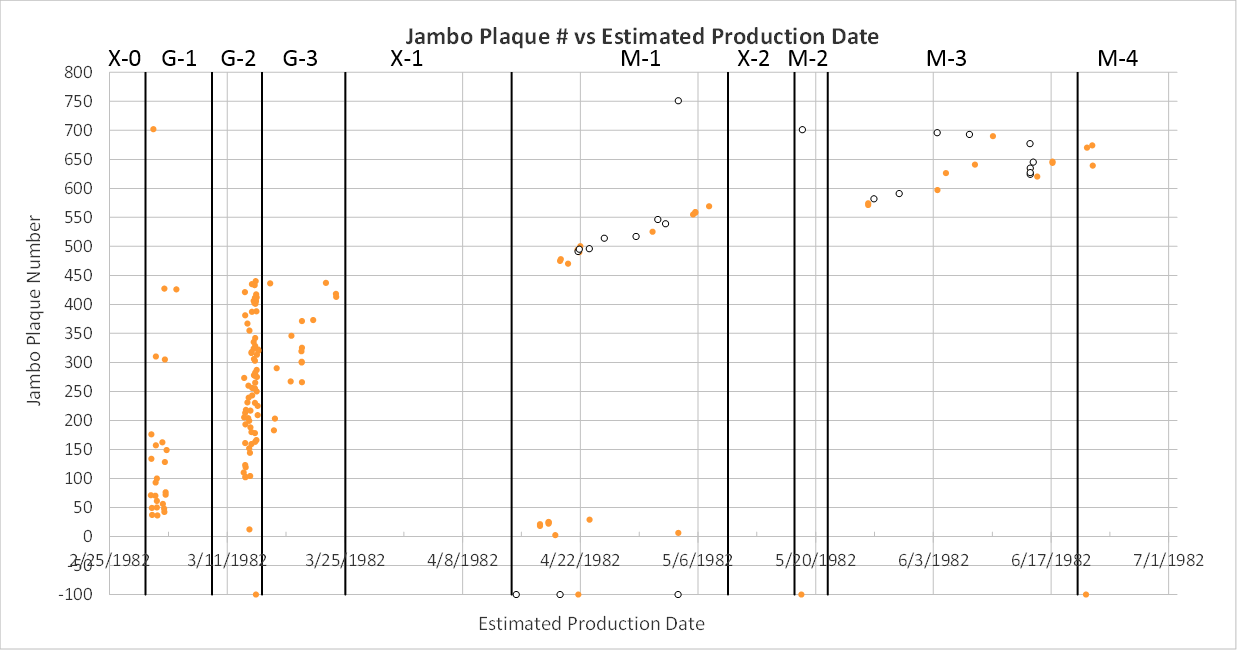
The first group of Jambos, which we call the Gold (G) Group, were all painted Topaz Gold Metallic. We believe about 412 Jambos were made at this time, including Jambos #0031 through about #0442. Jeep held out #0001-#0030 for later production.
We estimate that production began around March 1, 1982, and that the G Jambos were all built over a four-week period. We believe that this group of Jambos was the speculative sales group that was sent out to the dealerships. As you can see in the chart above, the sequential serial numbers for the G group range from about 039000 through 045000.
In addition to being painted gold, we suspect that these Jambos all conformed to the original Jambo specs laid out by Jeep in their Product Direction Letters, including the exclusion of factory-installed air conditioning.
The G group was produced in three batches, which we refer to the G-1, G-2, and G-3 batches. Plaque numbers tend to increase as you move from the G-1 to the G-3 group, however, the overlap is considerable. For example, #0440 was produced in the G-2 batch, whereas, #0266 was produced in the G-3 batch. It does seem that Jeep produced #0031 through #0100 in the G-1 batch. Within the G group, the G-2 batch was the largest.
We believe Jeep planned to make through Jambo #0450 (excluding #0001-#0030) in this first group of Jambos, but that numbers #0443-#0450 were ultimately not used. This is one part educating guessing and one part speculation: The G group was built during the month of March 1982. These Jambos were more or less batch built. At this point, Jeep had badges #0001-#2500. So, they likely pulled out the badges they wanted to use for this initial run and set them aside. It is easy to think that they just pulled through #0450, rather than #0442. However, they did not need all these badges during the first run. So some were left over. At this point, we suspect that someone took the left over badges home.
Within each batch, Jambo plaque numbers were assigned (almost) randomly as Jambos came down the line--not serially. This means that within a particular batch, a Jambo with a higher serial number could have a lower plaque number. If you think about the production line, this makes sense. The G group was the initial large run of Jambos. At some point in the production line, Jeep must have had a bin of Jambo plaques. Rather than laying all the plaques out in order, the line worker simply reached in the bin, pulled out a number, and installed it on the Jambo. You can read more about the serializing of Jambo plaque numbers below.
As you can see, there seem to be a few outliers within the G-1 batch. We believe these Jambos were specially numbered, perhaps for particular dealers or employees.
The Jambo Registry believes the Mixed (M) Group included about 216 Jambos, consisting of Jambos #0001 through #0030 and perhaps #0451 through #0698 (#0701, #0702, and #0751 were likely rebadged at a later date or specially numbered; The Jambo Registry holds NOS badge #0699). This group of Jambos began production about two weeks after the initial run of Jambos were completed. As discussed above, the G group went through about #0442. We believe badges #0443 through #0449 were not used. In total, we think Jeep skipped about 70 numbers during this run.
As you can see in the chart above, the M Jambos were produced in small batches--these were specially ordered Jambos. It is likely these Jambos were specially ordered by individual buyers. Because of this, Jeep allowed some changes to be made, including the addition of an Olympic White (9B) paint option. The Olympic White option is listed in the Jambo sales brochure, which is dated 3/82. So, this deviation from the original Jambo specs must have been made sometime in late February or early March 1982, as the inital G group was nearing completion.
The addition of Olympic White was likely done based on early dealer feedback. Jeep sales were very low in 1981-1982 and dealers may have feared that the more expensive, and gold, Jambos would not sell well. Gold has never been a popular car color. White has always been the most popular automobile color. The Jambo Registry estimates that about 69 (32%) of the M Jambos were white and 147 (68%) were gold. While painting the Jambos white might have increased sales, it did remove the primary and unique feature of the Jamboree trim package, as defined in the Jeep Product Direction Letters. We also believe that Jeep allowed factory installed air conditioning at this point, as well as a hardtop, and an automatic transmission.
Interestingly, #0001 through #0030 were not the first Jambos made. Rather, they were made after the initial large run of around 412 Jambos. This was likely done to save low numbers for special people, such as important employees and dealers. AMC followed this same strategy in their serializing of the AMX, which is the only other AMC vehicle to have been serialized. We believe #0001 through #0030 were all Topaz Gold, but are not certain of this (all 11 known Jambos from this batch are Topaz).
We have divided the M Group into four batches, M-1 through M-4. As you can see in the chart above, Jeep made sure to start with lower plaque numbers and moved up as more Jambos were ordered. This make sense. At this point in the production run, Jeep did not know how many Jambos would ultimately be purchased. So, they would wait until they had a sufficient number of orders and then produce a batch of Jambos using the next available plaque numbers. However, as with the G Group, within a batch, the numbers were not always assigned in sequential order. The relationship is better than the G Group, but not perfect. We believe Jeep better matched plaque numbers to serial numbers in the M group because they were producing much smaller batches. This would have made it easier for a line worker to keep track of the plaque numbers.
We also believe that producing the Jambos in small batches led Jeep to skip some Jambo badge numbers. When Jeep finished a particular batch, they likely had some plaques left over. Were these returned to the stock? We think they may not have been. For example, there is a large gap in numbers between what we think is the end of the G group and the start of the M group. For example, we don't know of any Jambos between #0440 and #0454 (a gap of 13, which is very large), which is the range in which production shifted from the G group to the M group. There are also large gaps between #0478 - #0488 (9), #0500 - #0511 (10), #0546 - #0555 (8), #0598 - #613 (14), #0646 - #0657 (10), #0661 - #0670 (8), and #0677 - #0687 (9). In total, that is a gap of 68 plaque numbers. As we discuss below, through another method, we estimate that Jeep skipped about 70 plaque numbers during the M group. So, our estimates appear to be relatively robust: Jeep skipped about 33% of the possible numbers during the M group. This explains why Jeep may have produced through #0698 in the M group, but that we still estimate that Jeep only produced fewer than 630 Jambos in total.
Finally, we believe the serialzing of Jambo numbers in the M group ended around #0675 (which we have not found). Jambos with numbers above #0675 were likely to have been specially numbered. This is why higher numbers, such as #0696 appear in earlier batches.
In order to estimate the total number of Jambos produced from our sample of about 234, we need to apply some statistics. To do so, we use a method developed during World War II (WWII).
During WWII, the Allies needed to estimate German tank production. They did this by analyzing the serial numbers that appeared on captured or destroyed German tank gear boxes. In order to estimate the highest and yet unseen serial number you start with the highest serial number you have observed. Let's call that value N. You then add N/K to N and subtract 1, where K is the number of observed tanks. So, if you have seen a lot of tanks then you have also probably seen the highest number. If you have only seen a few tanks, then this formula allows for existence of higher numbered tanks. This is known as the German Tank Problem and you can read more about it here.
To estimate the number of Jambos produced we do the following:
1. We first assume that #0001 through #0030 were produced. This seems like a reasonable assumption since Jeep saved these low numbers and many owners would prefer lower numbers--even though we now know these Jambos were made late in the production run, not early. However, it could be that Jeep never used all these numbers. They did not use all the AMX numbers that they held out for special people. Yet, we have found 13 out of 30 Jambos in this group, which is 43%. This is very close to the fraction of Jambos we beleive we have found from the G group. Thus, we think Jeep did use numbers #0001 through #0030.
2. We then estimate the number of Jambos produced in the G group using the German Tank Model. We know of 159 Jambos from the G group (this is counting all numbers we know about, except mythical Jambos). Out of 159 known G Jambos , the highest number we know of is #0440. This yields as estimate of 440 + 440/159 - 1 = 442 for the highest Jambo number in the G group.
This may not mean that Jeep used all of these numbers! It is known that AMC lost many
AMX
badges or that they were stolen. Unused Jambo
badges come up for sale from time to
time.
The average gap between known Jambo numbers in
the G group is 1.8. This very close to what one would expect empirically if
Jeep drew 159 random numbers (plaques) between #0031 and #0442. There is, however, a gap of 12 between #0388 and
#0401. This is surprising, however, it could be random variation. We have
conducted a detailed analysis of the gap in Jambo numbers and conclude that the
evidence is not strong enough to say that Jeep skipped many numbers in the
G
group. Therefore, we estimate production for the G group of 412 Jambos.
We have found 159 or 39% of these Jambos. This also makes some sense, as it is
likely that about 2/3rds of the
original Jambo stock has gone to salvage over the last 36 years.
3. We cannot apply the German Tank Model to the M group because we believe Jeep skipped many plaque numbers in this group. For example, the gap between numbers in the group is 3.0, which is over twice that of the G group. This does not make sense if Jeep was uniformly selecting numbers between #0451 and #0700. Theoretically, the gap between Jambo numbers in the M group should be about 1.1. This is because the range of possible number is smaller than the G group.
Therefore, we back into the total number of M Jambos by assuming that we should have found the same fraction of M Jambos as G Jambos. We see no reason that M Jambos would have been more or less likely to survive than G Jambos. We know of 73 M Jambos (not including the mythical Jambos), which yields a production estimate of 73/0.39 = 189.
So, in total, we estimate that 30 + 412 + 189 = 631 Jambos were produced, which we round to 630. As we discuss below, we estimate that 560 of these were Topaz Gold Metallic and 70 were Olympic White.
In sum, it is clear that Jeep produced fewer than 650 Jambos, not 2500. Our best estimate is 630 Jambos, but it could be as low as 600. This production estimate makes the Jambo the rarest CJ-7 ever produced and one of the rarest Jeeps ever.
The Jambo is in the same rarity class as the 1971 Renegade II. 600 1971 Renegade IIs were produced with the following color breakdown: 200 Mint Green, 200 Baja Yellow, 150 Big Bad Orange, and 50 Riverside Red.
As discussed above, during the M group, Jeep allowed Jambos to be painted Olympic White. Just how many Jambos were white is an interesting question. As far as we know, no records exist.
We know of 25 white Jambos. This is about 38% of the known M Jambos. Therefore, we estimate that 38% x 189 = 72 white Jambos were produced, which we round to 70. Again, there is uncertainty about this number. The Jambo Registry estimates that it could be as low as 51 or as high as 92. Our best estimate is that about 70 Olympic White Jambos were produced.
This puts the Olympic White Jambo in the same rarity class as the 50 Riverside Red Renegade IIs. However, other CJs could have been painted white. White was not a special Jambo color like Topaz Gold Metallic, or like the special Renegade-II colors. In fact, on average 25% of vehicles are white. Jeep produced nearly 380,000 CJ-7s. So, there might have been nearly 100,000 white CJ-7s over this time. In 1982 alone, Jeep produced about 25,000 CJ-7s, with perhaps as many as 6,000 being white. So, you have to be careful looking for White Jambos!
The "unicorn" is the Olympic White Jambo with factory-installed TorqueFlite 999 automatic transmission. We believe that only about 11 of these Jambos were produce and only 4 are known to exist.
Jeep claimed that the Jambos were to be batch built and serially numbered. We now know that was not quite true. During the G group the numbers were partially serialized among the G-1, G-2, and G-3 batches. However, within a batch the numbers were more or less assigned randomly. It is likely a line worker just grabbed a number out of a bin and installed it on the next Jambo coming down the line. This can be seen in the figure below.
This figure plots the fraction of Jambos with a higher plaque number versus the fraction of Jambos that were made after the listed number. If the Jambos were actually serialized the plaque numbers should fall along the dotted diagonal line. For example, if 40% of the Jambos were made after a particular Jambo then 40% of the Jambos should have a higher plaque number. As you can see, this is not the case. There is a large amount of scatter during the G group. The Jambos were more or less serialized during the M group. The relationship is not perfect, but it is much better than the G group.
The purple numbers along the diagonal are reference points that highlight the Jambo plaque number that should have been used at this point in production if the Jambo numbers were actually serialized.
You can also see that Jambos #0001-#0030 (except #0012) were made out of sequence. They were made in June 1982, not March 1982. They were not the lowest numbers made. Rather, this was a gimmick that Jeep used to sell low numbers to special people or dealers. We cannot explain why #0012 does not fit this sequence. It might have been made for a special dealer in the initial large run of Jambos.
You can also see that some Jambos, in the upper 600s appear to have been specially numbered.
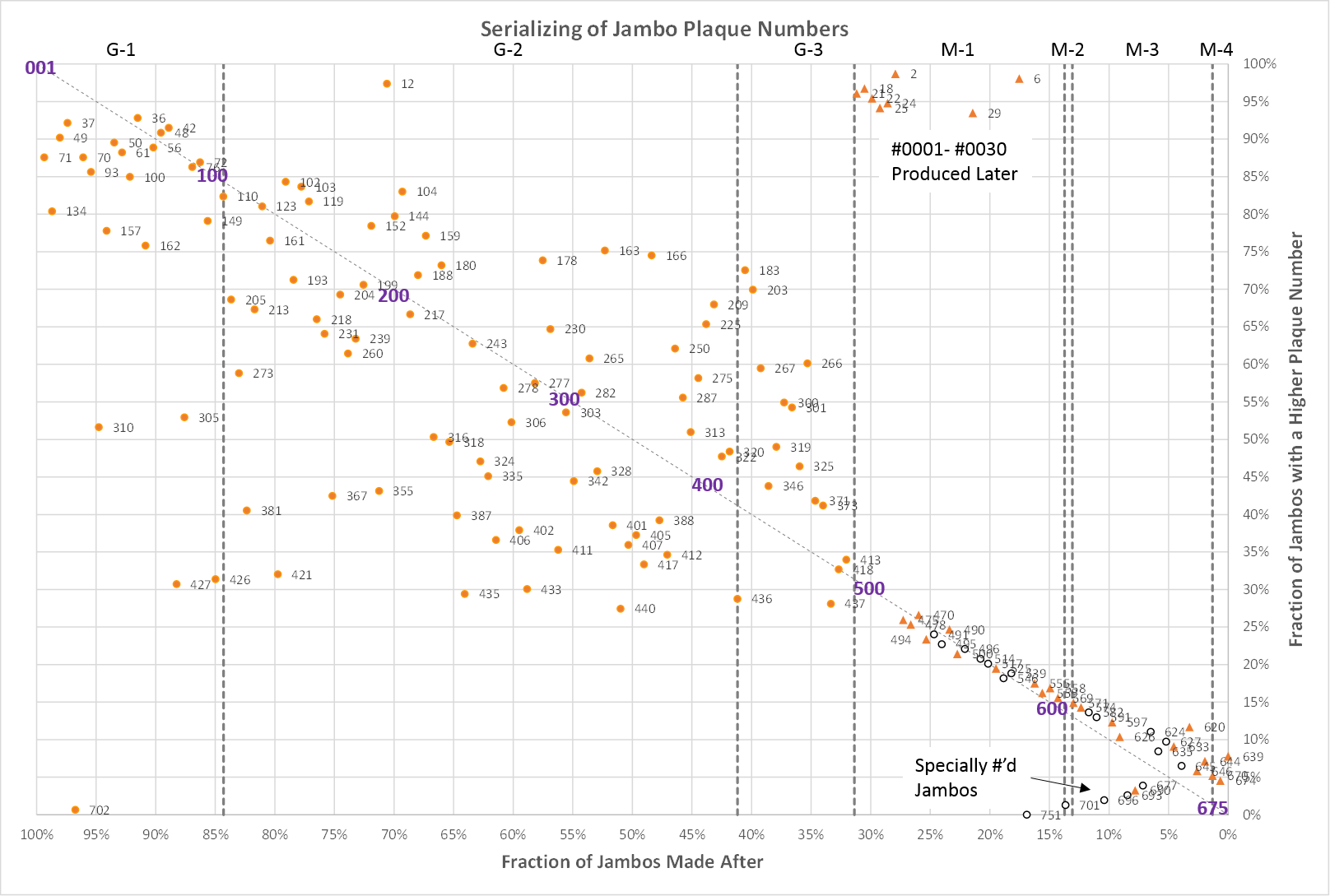
Another way to look at this is to plot Jambo Badge Number against the Estimated Production Number, which we do below. The production number is estimated based on the belief that about 630 Jambos were produced and that our sampling of Jambo numbers is not biased. If the Jambos were numbered serially then the data below should fall along the upward sloping line. Overall, the Jambos were numbered serially. However, there is a large amount of scatter in the G-Group. The M-Group was numbered more or less serially. Notice that the highest numbered Jambo, #0751, was not the last Jambo made.
The G-Group numbers are about 30 too high on average. This is because Jeep skipped the first 30 Jambo numbers and made them later. On average, the M-Group Jambo numbers are about 50 higher than the estimated production number. This implies that Jeep skipped numbers, which, as we discussed above, we believe they did.
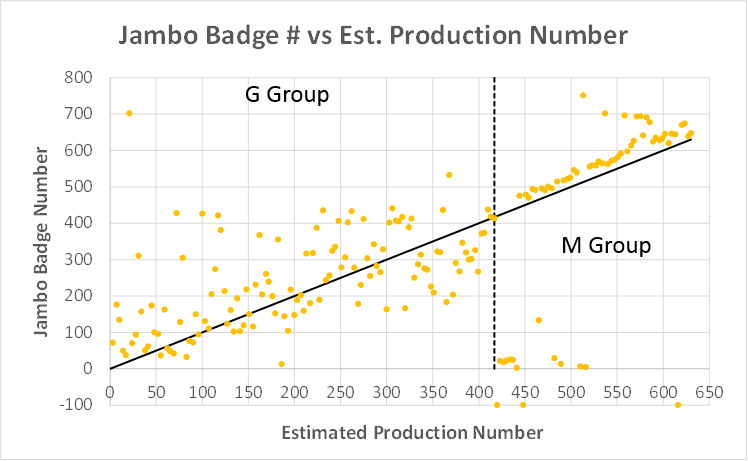
It is known that in the mid-1960s AMC assigned serial numbers as orders were placed, not as the vehicles were produced. However, we believe by 1982 this was not the case for Jeep vehicles. We have three pieces of evidence to support this:
1. Jambo engine production dates increase with serial production number.
2. Jambo wheel dates increase with serial production number.
3. Moveable window vents (wind wings) were introduced in 1982. We have studied their introduction carefully, covering CJ-7s and CJ-8s. This analysis, which you can read about here, makes is clear that wind wings were introduced late in the 1982 model year (arround sequential serial number 63000). This conclusion only makes sense if serial numbers were assigned based on production date.
As detailed in the Jambo RegistryTM, we have confirmed 148 Jambos. If you add in the Likely Jambos, we know of 173 Jambos. We are not including scrapped Jambos or mythical Jambos because we want to calculate the number of Jambos that currently exist and are left to find. The scrapped Jambos are gone and the mythical Jambos are in the group we want to find.
As we find new Jambos it gets harder to find the next one. For example, we found 51 Jambos the first year we started looking. Now, we might find 4 or 5 per year.
We fit a mathematical function to this data, which exhibits exponential decline. The result is that we estimate we have found about 90% of the Jambos that still exist. In total, we estimate that 273 Jambos remain in existence (243 2H + 30 9B). That would be about 43% of the original production. This does not mean these Jambos are all in good shape. Some could be very rusty or just a pile of parts and not restorable, or they could be in a salvage yard. 273 remaining Jambos means there are about 24 Jambos left to find that are not scrapped. Of these 24, we estimate that 21 are Topaz Gold Metallic and 3 are Olympic White. Can you find one?
Notice in the Jambo production chart, repeated below, that several Jambo numbers seem to be outliers. For example, #0696 (M-4), #0701 (M-3), #0702 (G-1), and #0751 (M-2) do not fit the production pattern.

We believe that #0702 was likely rebadged sometime after production because it was one of the first Jambos made and Jeep still believed they would sell 2500 at this time and, therefore, would not have tried to issue the largest potential badge number.
#0696, #0701, and #0751 were all white and were likely specially ordered and numbered. By this time in the production run it is likely that Jeep had decided it would not make more than around 700 Jambos. The fact that #0751 was made before the other special orders also suggests that around the time it was produced, Jeep might have thought that it would sell no more than 750 Jambos and someone wanted to have the highest number. This is just speculation, but one can see how it could have happened.
The other outliers are #0305 (G-1), #0310 (G-1), #0426 (G-1), #0427 (G-1). We suspect these Jambos were specially numbered during the G-1 batch. However, we have been unable to confirm that #0310 is actually a Jambo. It has a Jambo badge, but has been repainted. We need to see the VIN tag to confirm this Jambo.
|
© Copyright 2018. J. Eric Bickel. All rights reserved The Jambo Registry is a trademark of www.82jambo.com. UA-83787031-1 |